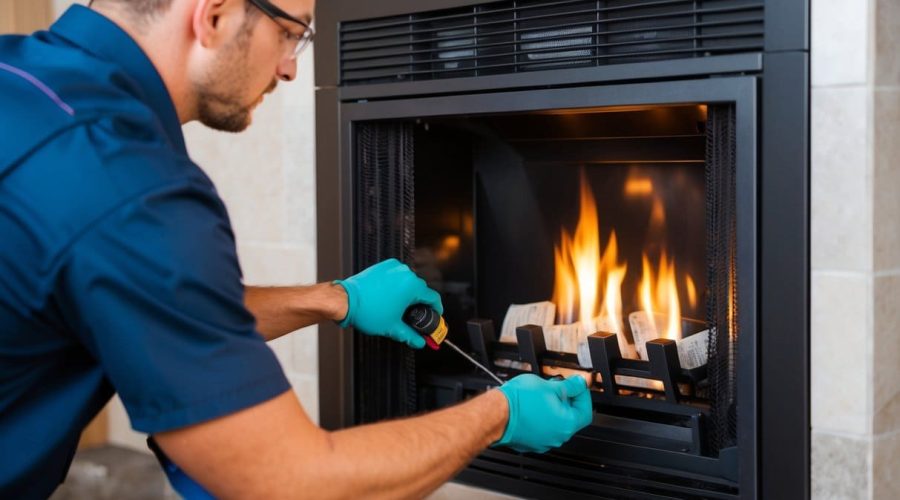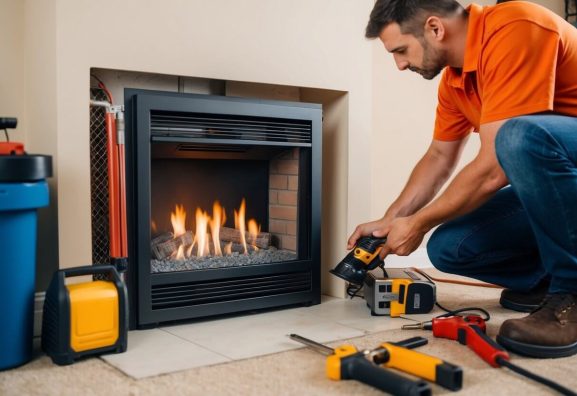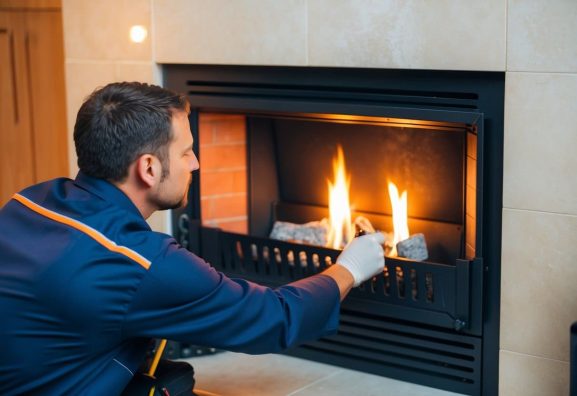Who Services Gas Fireplaces? Maintenance Experts
Gas fireplaces are a popular choice for home heating, offering both convenience and ambiance. Professionals, such as certified technicians and specialized service dealers, are essential for maintaining and servicing gas fireplaces to ensure safety and efficiency. Proper maintenance can prevent issues and prolong the lifespan of the fireplace, making it crucial for homeowners to understand whom to call for service
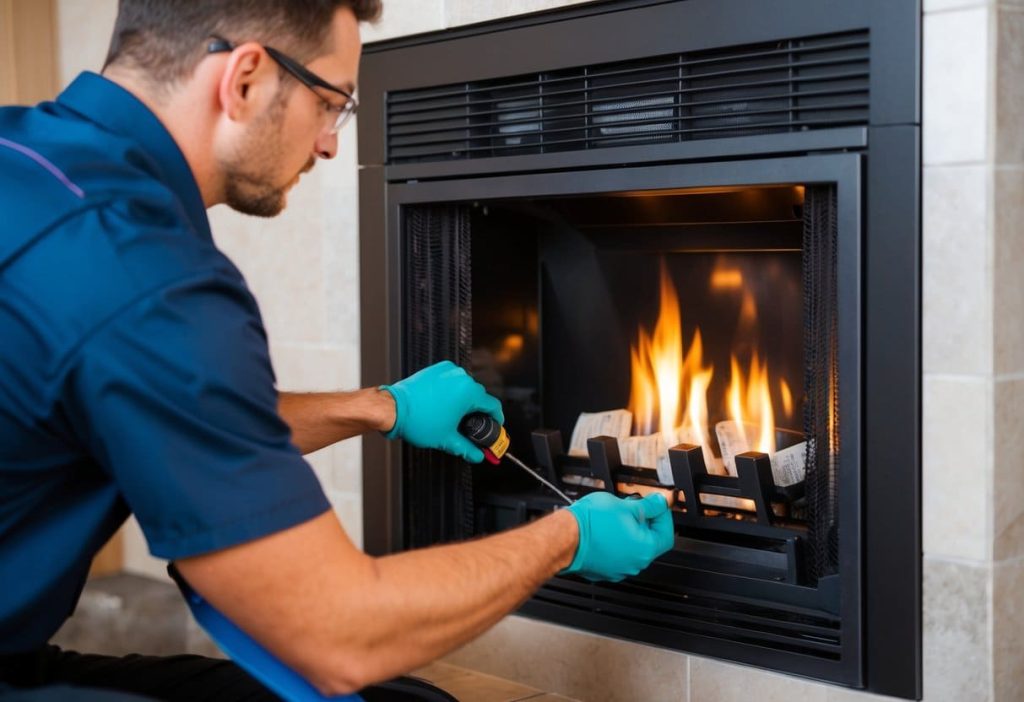
Routine servicing includes tasks such as inspecting ignition systems, adjusting burner settings, and cleaning components. These tasks can typically be handled by qualified professionals who are trained to identify potential hazards and fix common problems. For those who prefer a DIY approach, basic maintenance can also be performed, but certain complex issues may still require an expert’s attention.
Finding a reliable service provider is key to ensuring the functionality of a gas fireplace. With the right professional, homeowners can keep their fireplaces running smoothly while enhancing safety and comfort in their living spaces.
Key Takeaways
- Professionals are vital for effective gas fireplace maintenance.
- Routine inspections help identify and prevent common issues.
- Understanding how to troubleshoot can aid in minor repairs.
Understanding Gas Fireplaces
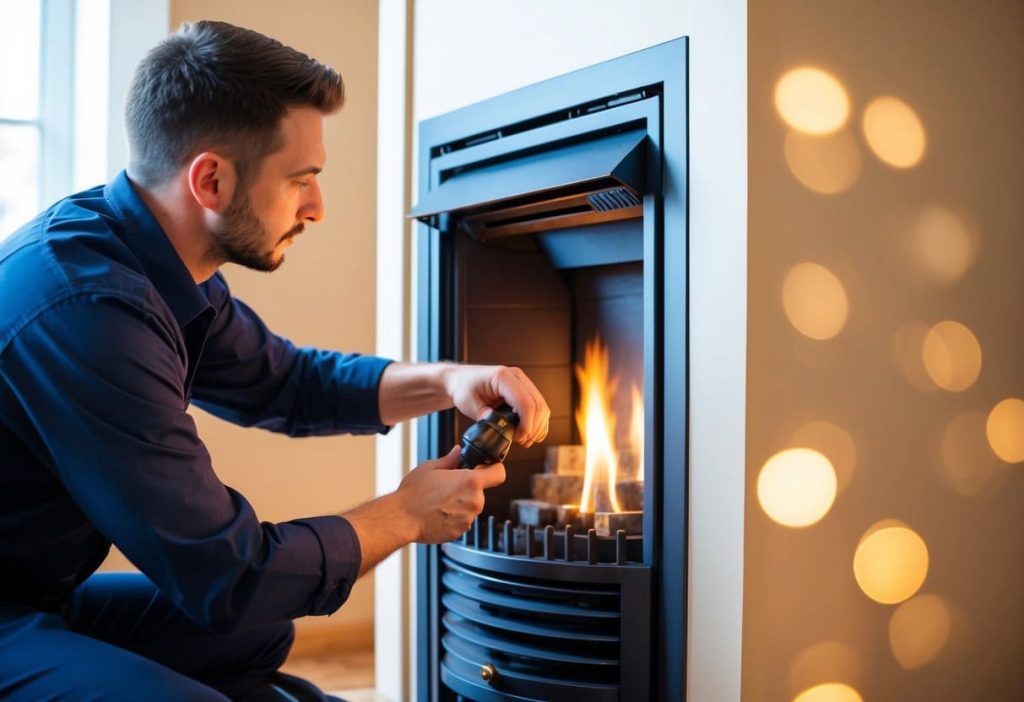
Gas fireplaces offer homeowners a combination of efficiency, convenience, and elegance. They come in various types and designs, making them suitable for different aesthetics and functional needs.
Types of Gas Fireplaces
There are three primary types of gas fireplaces: insert fireplaces, built-in models, and freestanding units.
- Gas Insert Fireplaces: Designed to fit into an existing wood fireplace, these inserts provide an efficient heating solution by using gas logs. They often require venting and come with varying styles to match aesthetic preferences.
- Built-In Gas Fireplaces: These are integrated directly into the wall, offering a sleek and modern look. They can be customized with various surrounds and finishes.
- Freestanding Gas Fireplaces: Available in classic or contemporary styles, these units can be placed anywhere in the room. They are portable and do not require extensive installation.
Comparing Gas, Wood, and Pellet Stoves
When comparing gas, wood, and pellet stoves, several factors come into play: convenience, environmental impact, and maintenance.
- Gas Fireplaces: They ignite quickly and require less maintenance. Gas is generally cleaner, emitting fewer particulates compared to wood.
- Wood Fireplaces: These provide a traditional ambiance but need regular cleaning and wood supply. They have a higher environmental impact due to emissions.
- Pellet Stoves: Utilizing compressed wood pellets, these stoves offer efficient heating. They require electricity for operation and have specific storage needs for fuel.
Each option has its advantages, with gas fireplaces generally standing out for convenience and cleanliness.
Key Components of a Gas Fireplace
Understanding the key components of a gas fireplace is essential for proper servicing and maintenance.
- Burner: The burner is where the gas ignites, creating flames.
- Log Set or Glass Media: This is decorative and enhances the fireplace’s visual appeal.
- Venting System: Ensures safe exhaust of gases and can be either direct vent or vent-free.
- Thermostat and Control Valve: Regulates the temperature and flame height, adding convenience to operation.
Regular inspection of these components is crucial to ensure safety and functionality, particularly for those who wish to keep their fireplace in optimal condition.
Routine Gas Fireplace Maintenance
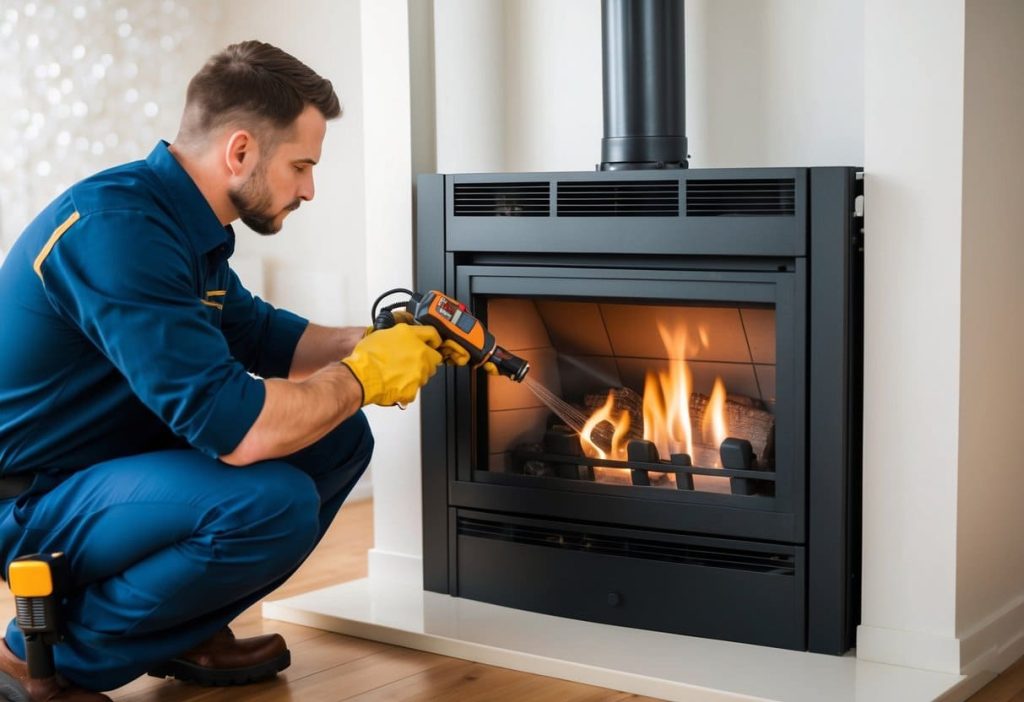
Regular maintenance of gas fireplaces is crucial for safety, efficiency, and longevity. Scheduling routine services ensures that the fireplace works correctly and reduces the risk of malfunctions. Below are essential aspects of gas fireplace maintenance.
Maintenance Services Overview
Routine maintenance services for gas fireplaces typically include inspection, cleaning, and minor repairs. A certified technician performs these tasks to ensure optimal performance.
Key components of a maintenance service might involve:
- Inspection: Checking for gas leaks, ensuring proper ventilation, and assessing the overall condition of the fireplace.
- Cleaning: Removing dust and debris from vents and burners to promote efficiency.
- Adjustments: Ensuring that the flame burns properly and the pilot light functions effectively.
Some homeowners may opt for a priority service program that offers regular service appointments, ensuring peace of mind throughout the heating season.
Full-Service Tune-Up
A full-service tune-up goes beyond standard maintenance by covering more comprehensive checks and services. This process typically should be performed at least once a year.
During a tune-up, a technician will:
- Examine logs and glass for cracks or damage.
- Clean or replace the carbon monoxide detector to enhance safety.
- Replace any worn or faulty components, such as burners or valves, to ensure safety and performance.
Homeowners who frequently use their gas fireplace might consider additional tune-ups at the beginning and end of the heating season for optimal reliability.
Safety Measures and Best Practices
Safety is paramount when it comes to gas fireplaces. Regular maintenance helps identify potential hazards and keeps the system running smoothly.
Best practices for maintaining safety include:
- Ensuring that carbon monoxide detectors near the fireplace are functioning correctly.
- Scheduling annual services with certified technicians who have expertise in gas appliances.
- Keeping the area around the fireplace clear of any flammable materials.
These measures not only enhance safety but also extend the life of the fireplace, minimizing the need for costly replacements and repairs. Regular attention to these details fosters a safe and enjoyable heating experience.
Troubleshooting Common Gas Fireplace Issues

Gas fireplaces offer convenience and efficiency, but they may experience various issues that require troubleshooting. Key problems can arise from gas leaks, ignition failures, thermocouple malfunctions, and issues related to log sets and gas valves.
Identifying Gas Leaks and Ignition Problems
Gas leaks can pose serious safety risks. A homeowner should regularly check for unusual smells resembling rotten eggs, which typically indicate a gas leak. Using soapy water to test connections can be effective; bubbles form when gas escapes.
Ignition problems often stem from a faulty pilot light or ignition system. If the pilot light won’t stay lit, it may signal a thermocouple failure. The thermocouple serves as a safety device, shutting off gas flow if the pilot flame is interrupted. Ensuring the pilot light’s and thermocouple’s proper function is crucial for safe operation.
Thermocouple Failures and Pilot Light Difficulties
Thermocouple failures can lead to significant gas fireplace issues. If the fireplace shuts off unexpectedly, the thermocouple may not be generating sufficient voltage. Inspecting the thermocouple for dirt or damage is essential. Cleaning or replacing it can restore functionality.
Pilot light difficulties may also be caused by blockages in the pilot tube. A blocked tube will not provide enough gas to sustain the flame. Regular maintenance, including cleaning the pilot light and checking for obstructions, can help prevent these issues from occurring.
Handling Log Sets and Gas Valve Concerns
Problems with log sets can not only affect aesthetics but also function. Logs improperly placed can obstruct airflow, hindering efficiency. Ensure that the logs are arranged according to manufacturer guidelines for optimal operation.
Gas valve issues can lead to insufficient gas flow, resulting in weak flames or complete shutdowns. It is vital to check the gas valve settings and ensure they are fully opened. If problems persist, consulting a qualified technician for repairs or adjustments is recommended. Regular inspection and maintenance of these components can mitigate risks and enhance safety.
Professional Gas Fireplace Services
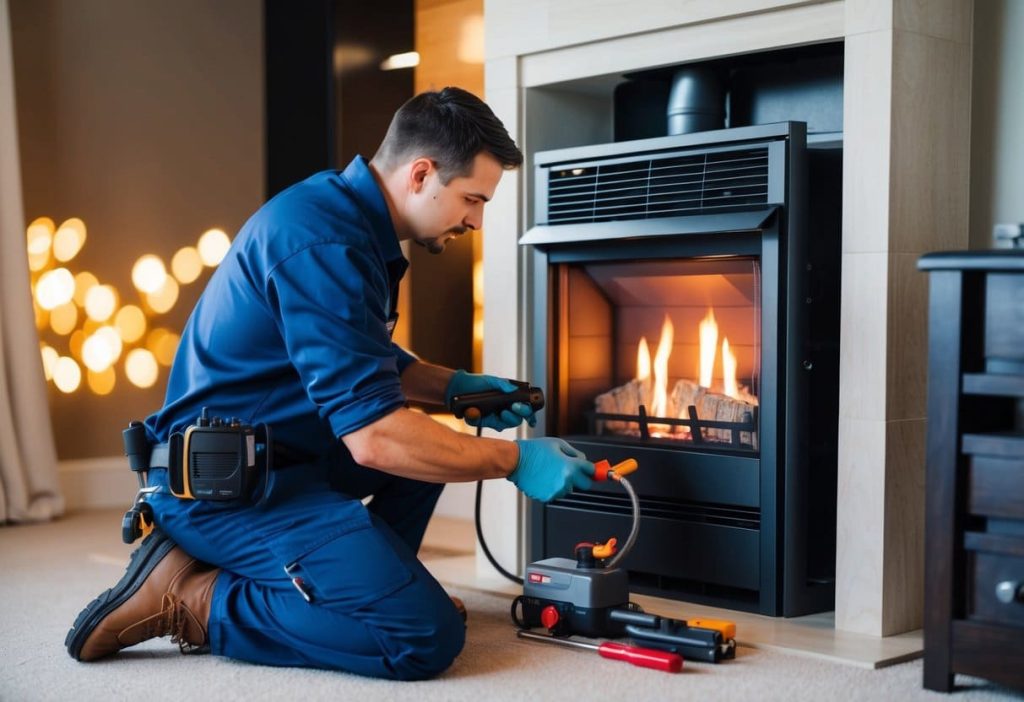
Hiring Professionals for Gas Fireplace Servicing: Why Choose Us?
Regular servicing is essential to keep your gas fireplace running safely and efficiently. At gasfireplacecleaning.com, we are a trusted company serving multiple locations, offering expert technicians who specialize in gas fireplace maintenance and repairs. Whether you need a routine check-up or a more extensive repair, our professionals ensure your fireplace operates at peak performance.
Why Choose Our Services?
Maintaining your gas fireplace requires the expertise of certified professionals. At gasfireplacecleaning.com, we offer specialized services across various locations, ensuring you have access to reliable and prompt maintenance wherever you are.
- Certified Technicians: Our team of skilled, certified professionals ensures that your fireplace is serviced according to the latest safety standards.
- Local Service Availability: We operate in multiple regions, making it convenient for you to schedule servicing at your location. No matter where you are, our technicians are just a call away.
- Transparent Pricing: Our services come with clear, upfront pricing, so you know what to expect without worrying about hidden fees.
Certified and Safe Servicing
Our technicians hold certifications such as National Fireplace Institute (NFI), ensuring that your gas fireplace is serviced with the utmost care and compliance with industry standards. We prioritize safety by thoroughly inspecting and maintaining every aspect of your fireplace, from gas connections to ventilation systems.
Reliable and Convenient
At gasfireplacecleaning.com, we make it simple to keep your gas fireplace in excellent condition. By choosing us, you ensure that experienced professionals handle all aspects of your fireplace servicing, giving you peace of mind and a well-functioning heating system.
Preventing Potential Hazards
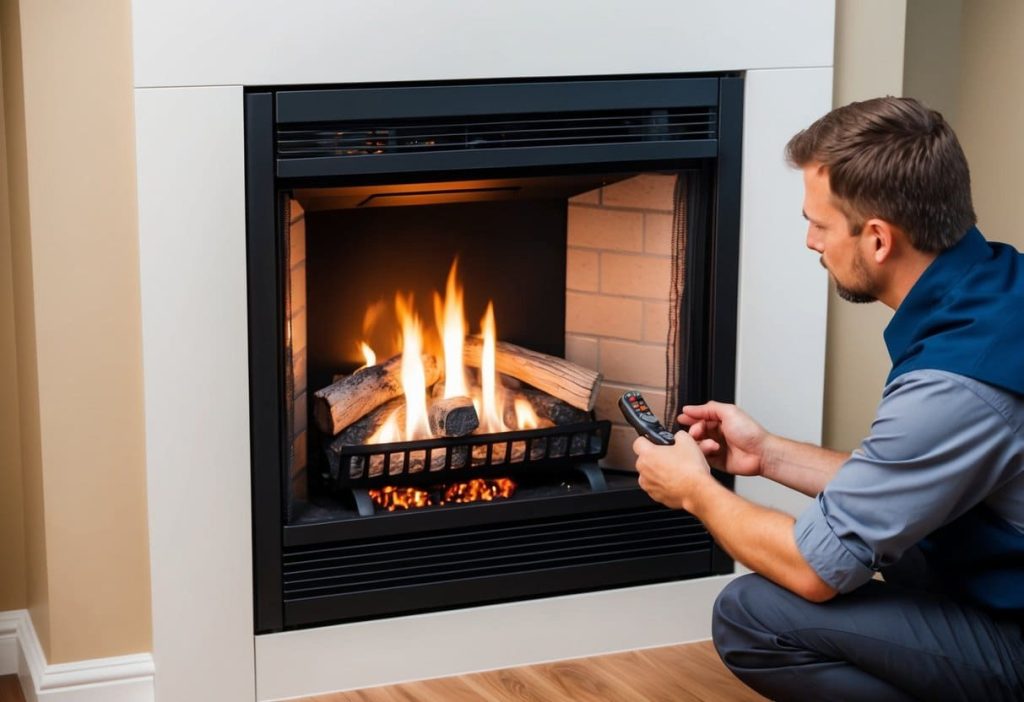
Regular maintenance and precautionary measures are essential for ensuring the safe operation of gas fireplaces. Focusing on chimney inspections and carbon monoxide detection can significantly reduce the risks associated with gas fireplaces.
Regular Chimney Inspections
Regular chimney inspections are crucial for maintaining a gas fireplace’s safety. These inspections should be performed at least once a year by a qualified technician. During an inspection, the technician will look for blockages, creosote buildup, and structural issues.
Signs that a chimney needs attention include:
- Unusual odors
- Smoke or soot buildup
- Cracks in the chimney structure
A clean chimney facilitates proper ventilation, reducing the risk of gas leaks or harmful emissions. Neglecting this step may lead to dangerous situations, including potential fires or carbon monoxide poisoning.
Carbon Monoxide Detection and Prevention
Carbon monoxide (CO) is a colorless, odorless gas produced during gas combustion. Installing carbon monoxide detectors near gas fireplaces is essential for preventing CO buildup in the home. These detectors should be placed on each floor of the building and tested monthly.
To enhance safety:
- Replace batteries in detectors annually.
- Follow manufacturer guidelines for placement.
- Create an emergency plan if a CO alarm sounds.
Regularly servicing gas fireplaces by professionals is another proactive measure to prevent CO leaks. Homeowners must remain vigilant and address any signs of gas leaks immediately, ensuring exhaust systems are functioning correctly.
Frequently Asked Questions

Many homeowners have inquiries regarding the servicing of gas fireplaces. Addressing these concerns helps ensure that gas fireplaces operate efficiently and safely throughout their lifespan.
How often should a gas fireplace be serviced for optimal performance?
Gas fireplaces should ideally be serviced annually. Regular maintenance helps ensure performance efficiency and safety, identifying any potential issues before they become major problems.
What is the typical range of costs associated with gas fireplace maintenance?
Costs for gas fireplace maintenance typically range from $100 to $300. The price depends on factors such as the service provider, the complexity of the work needed, and the location of the fireplace.
What are the signs that a gas fireplace needs cleaning or inspection?
Signs that a gas fireplace requires cleaning or inspection include difficulty igniting, uneven flames, or noticeable soot buildup. An unusual odor or poor ventilation can also indicate it’s time for service.
Where can I find a reputable gas fireplace cleaning service in my area?
Homeowners can search online directories, check customer reviews on websites, or ask for recommendations from friends and family. Local home improvement stores may also have contacts for reputable service providers.
Is annual inspection necessary for a ventless gas fireplace?
Yes, an annual inspection of a ventless gas fireplace is crucial. Despite lacking a vent, it still requires regular checks to ensure safety and optimal operation due to the buildup of combustion byproducts.
What are the steps involved in professional gas fireplace installation?
Professional gas fireplace installation typically involves site assessment, ensuring proper venting, gas line connection, and safety inspections. The technician will also provide guidance on operation and maintenance.

